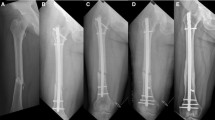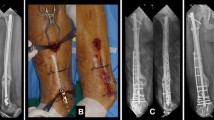Abstract
Introduction
Owing to its distinct biomechanical properties, nonunion is common (7–20%) after intramedullary (IM) nailing of subtrochanteric femoral fractures. Unlike diaphyseal nonunion, it is difficult to provide sufficient stability by exchanging nailing alone in subtrochanteric nonunion. This study investigated the clinical outcomes of femoral subtrochanteric nonunion initially treated with an IM nail and subsequently managed with minimally invasive augmentative plate fixation.
Materials and methods
Nineteen patients were enrolled retrospectively. The mechanisms of initial injury were traffic accidents in 8, falls from a height in seven, and slipping in two patients. Two patients with atypical subtrochanteric femoral fractures without a specific trauma history were further included. All patients underwent IM nailing as the index operation. Nonunion surgery was performed an average of 45.2 weeks after the initial surgery. In cases of hardware damage and/or atrophic nonunion, exchange nailing and bone grafting were performed in addition to augmentative plating, as necessary. Conversely, augmentative plating alone was performed in cases of hypertrophic nonunion without any failure of the preexisting IM nail or malalignment. A narrow locking compression plate was fixed after contouring according to the shape of the proximal femur. The mean follow-up period was 36.1 months.
Results
Bony union was achieved in 18/19 patients (94.7%), at an average of 19.8 weeks after nonunion surgery. In the case that did not heal even after exchange nailing, additional plating and bone grafting, further autogenous bone grafting was required after 11 months, which healed uneventfully. There were 2 cases of soft tissue irritation over the plate, but no major complications were observed.
Conclusions
Additional plate augmentation over a retained IM nail yields satisfactory outcomes in terms of the bony union in subtrochanteric nonunion. Given its expected biomechanical superiority and relatively easy surgical technique, it may be a reasonable option for the management of femoral subtrochanteric nonunion.





Similar content being viewed by others
References
Krappinger D, Wolf B, Dammerer D, Thaler M, Schwendinger P, Lindtner RA (2019) Risk factors for nonunion after intramedullary nailing of subtrochanteric femoral fractures. Arch Orthop Trauma Surg 139:769–777
Haidukewych GJ, Berry DJ (2004) Nonunion of fractures of the subtrochanteric region of the femur. Clin Orthop 419:185–188
Yun HH, Oh CH, Yi JW (2013) Subtrochanteric femoral fracture during trochanteric nailing for the treatment of femoral shaft fracture. Clin Orthop Surg 5:230–234
Yoon RS, Donegan DJ, Liporace FA (2015) Reducing subtrochanteric femur fractures: tips and tricks, do’s and dont’s. J Orthop Trauma 29(Suppl 4):S28-33
Craig NJ, Sivaji C, Maffulli N (2001) Subtrochanteric fractures. A review of treatment options. Bull Hosp Jt Dis 60:35–44
Kang S, McAndrew MP, Johnson KD (1995) The reconstruction locked nail for complex fractures of the proximal femur. J Orthop Trauma 9:453–463
Valverde JA, Alonso MG, Porro JG, Rueda D, Larrauri PM, Soler JJ (1998) Use of the gamma nail in the treatment of fractures of the proximal femur. Clin Orthop Relat Res 350:56–61
Parker MJ, Dutta BK, Sivaji C, Pryor GA (1997) Subtrochanteric fractures of the femur. Injury 28:91–95
Siebenrock KA, Müller U, Ganz R (1998) Indirect reduction with a condylar blade plate for osteosynthesis of subtrochanteric femoral fractures. Injury 29(3 Suppl.):C7-15
Sims SH (2002) Subtrochanteric femur fractures. Orthop Clin N Am 33:113–26.viii
Giannoudis PV, Ahmad MA, Mineo GV, Tosounidis TI, Calori GM, Kanakaris NK (2013) Subtrochanteric fracture nonunions with implant failure managed with the “Diamond” concept. Injury 44(Suppl 1):S76-81
Lo YC, Su YP, Hsieh CP, Huang CH (2019) Augmentation plate fixation for treating subtrochanteric fracture nonunion. Indian J Orthop 53:246–250
Brinker MR, O’Connor DP (2007) Exchange nailing of ununited fractures. J Bone Jt Surg Am 89-A:177–188
Amorosa LF, Jayaram PR, Wellman DS, Lorich DG, Helfet DL (2014) The use of the 95-degree-angled blade plate in femoral non-union surgery. Eur J Orthop Surg Traumatol 24:953–960
Lotzien S, Rausch V, Schildhauer TA, Gessmann J (2018) Revision of subtrochanteric non-unions after intramedullary nailing with dynamic condylar screw. BMC Musculoskelet Disord 19:448
Balasubramanian N, Babu G, Prakasam S (2016) Treatment of nonunions of subtrochanteric fractures using an anatomical proximal femur locked compression plate-a prospective study of 13 patients. J Orthop Case Rep 6:65–68
Somford MP, van den Bekerom MP, Kloen P (2013) Operative treatment for femoral shaft nonunions, a systematic review of the literature. Strateg Trauma Limb Reconstr 8:77–88
Pihlajamäki HK, Salminen ST, Böstman OM (2002) The treatment of nonunions following intramedullary nailing of femoral shaft fractures. J Orthop Trauma 16:394–402
Swanson EA, Garrard EC, Bernstein DT, O’Connor DP, Brinker MR (2015) Results of a systematic approach to exchange nailing for the treatment of aseptic femoral nonunions. J Orthop Trauma 29:21–27
Dietze C, Brand A, Friederichs J, Stuby F, Schneidmueller D, von Rüden C (2022) Results of revision intramedullary nailing with and without auxillary plate in aseptic trochanteric and subtrochanteric nonunion. Eur J Trauma Emerg Surg 48:1905–1911
Johnson KD, Tencer AF, Blumenthal S, August A, Johnston DW (1986) Biomechanical performance of locked intramedullary nail systems in comminuted femoral shaft fractures. Clin Orthop Relat Res 206:151–161
Weresh MJ, Hakanson R, Stover MD, Sims SH, Kellam JF, Bosse MJ (2000) Failure of exchange reamed intramedullary nails for ununited femoral shaft fractures. J Orthop Trauma 14:335–338
Banaszkiewicz PA, Sabboubeh A, McLeod I, Maffulli N (2003) Femoral exchange nailing for aseptic non-union: not the end to all problems. Injury 34:349–35624
Yang KH, Kim JR, Park J (2012) Nonisthmal femoral shaft nonunion as a risk factor for exchange nailing failure. J Trauma Acute Care Surg 72:60–64
Vaishya R, Agarwal AK, Gupta N, Vijay V (2016) Plate augmentation with retention of intramedullary nail is effective for resistant femoral shaft non-union. J Orthop 13:242–245
de Vries JS, Kloen P, Borens O, Marti RK, Helfet DL (2006) Treatment of subtrochanteric nonunions. Injury 37:203–211
Chen CM, Su YP, Hung SH, Lin CL, Chiu FY (2010) Dynamic compression plate and cancellous bone graft for aseptic nonunion after intramedullary nailing of femoral fracture. Orthopedics 33:393
Chiang JC, Johnson JE, Tarkin IS, Siska PA, Farrell DJ, Mormino MA (2016) Plate augmentation for femoral nonunion: more than just a salvage tool? Arch Orthop Trauma Surg 136:149–156
Garnavos C (2017) Treatment of aseptic non-union after intramedullary nailing without removal of the nail. Injury 48(Suppl 1):S76–S81
Jhunjhunwala HR, Dhawale AA (2016) Is augmentation plating an efffective treatment for non-union of femoral shaft fractures with nail in situ? Eur J Trauma Emerg Surg 42:339–343
Shukla S, Johnston P, Ahmad MA, Wynn-Jones H, Patel AD, Walton NP (2007) Outcome of traumatic subtrochanteric femoral fractures fixed using cephalomedullary nails. Injury 38:1286–1293
Barquet A, Mayora G, Fregeiro J, Lopez L, Rienzi D, Francescoli L (2004) The treatment of subtrochanteric non-unions with the long gamma nail: twenty-six patients with a minimum 2-year follow-up. J Orthop Trauma 18:346–353
Funding
This research was supported by a grant of the Korea Health Technology R&D Project through the Korea Health Industry Development Institute (KHIDI), funded by the Ministry of Health & Welfare, Republic of Korea (grant number: HR22C1832).
Author information
Authors and Affiliations
Corresponding author
Ethics declarations
Conflict of interest
The authors have no competing interests to declare that are relevant to the content of this article.
Ethical approval
This article does not contain any studies with human participants or animals performed by any of the authors. The design and protocol of this study were approved by the institutional review board of Kyungpook National University Hospital.
Informed consent
Informed consent was obtained from all individual participants included in the study.
Additional information
Publisher's Note
Springer Nature remains neutral with regard to jurisdictional claims in published maps and institutional affiliations.
Rights and permissions
Springer Nature or its licensor (e.g. a society or other partner) holds exclusive rights to this article under a publishing agreement with the author(s) or other rightsholder(s); author self-archiving of the accepted manuscript version of this article is solely governed by the terms of such publishing agreement and applicable law.
About this article
Cite this article
Kim, JW., Oh, CW., Park, KH. et al. The role of an augmentative plating in the management of femoral subtrochanteric nonunion. Arch Orthop Trauma Surg 143, 4915–4923 (2023). https://doi.org/10.1007/s00402-023-04767-4
Received:
Accepted:
Published:
Issue Date:
DOI: https://doi.org/10.1007/s00402-023-04767-4




